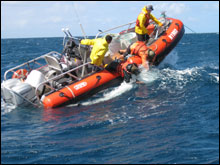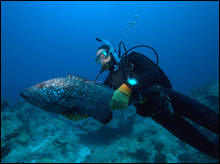Error processing SSI file
|
Mission Blog: August 24, 2008
Shark Team Blog
Today, our blog entry comes from Melanie Hutchinson, one of the members of the Apex Predator Team. Dr. Carl Meyer of the Hawaii Institute of Marine Biology led the team, ably assisted by Jon Dale and Melanie. This intrepid trio has spent the last month tagging impressive-sized sharks and grouper. Archaeology can be quite exciting, but you would be hard pressed to top the exhilaration of performing surgery on a 14-foot Tiger shark from a small boat in the open sea.
By Melanie Hutchinson
 |
|
Jon Dale releases Hawaiian grouper after implantation of acoustic monitoring tag.(Photo: NOAA ONMS)
|
The objectives for this project are to answer questions regarding the movement patterns and habitat size and utilization of apex predatory fish and sharks by using telemetry monitoring. For this trip we focused our efforts on several shark species found in the Northwestern Hawaiian Islands and the endemic Hawaiian grouper, “hapu’upu’u.” Our shark tagging efforts were centered at French Frigate Shoals. The goal here is to develop an understanding of the fine scale movement patterns of the larger shark species, specifically Galapagos sharks (Charcharinus galapagensis) and Tiger sharks (Galeocerdo cuvier) near monk seal pupping beaches. To do this, we surgically implant acoustic tags, “pingers,” into target shark species. We have receivers installed at key locations around the atoll and up and down the entire Hawaiian island chain to pick up the sonic pings emitted by a tagged animal when it passes within the receiver’s range. With this technology we can see individual movement patterns and make inferences regarding a species habitat use. These types of data are very useful for best management practices.
 |
|
Jon Dale releases Hawaiian grouper after implantation of acoustic monitoring tag.(Photo: NOAA ONMS)
|
We implanted similar tags into the Hawaiian grouper (Epinephelus quernus). For this part of the project, we centered our efforts at Kure and Midway atolls. At these locations, grouper can be found at diving depths. So, we can tag these animals in their habitats and thus reduce the risk of injury that results from bringing a fish to the surface from deeper depths. Lower down the chain, this species is only found at much deeper depths. The grouper tagging was interesting--the fish usually came and found us. We were even followed for an entire dive by a grouper that was previously tagged during the June cruise to Kure.
Now that the adventure is over and we are pulling into Honolulu, it has been a great trip as well as a successful one with a good sample size of target species tagged. Hopefully, next year when we are able to return, we will be able to download all the receivers and see where our grouper and sharks are going and when.
|







